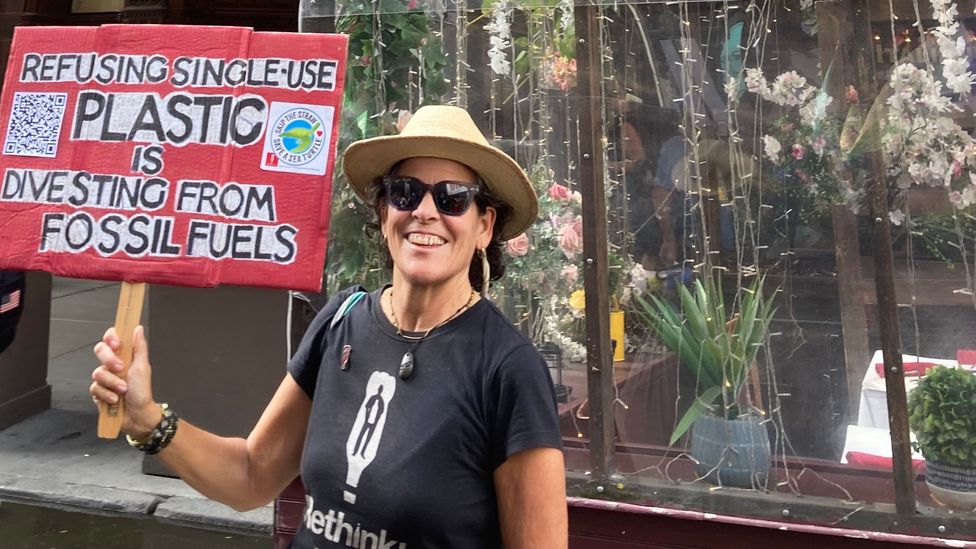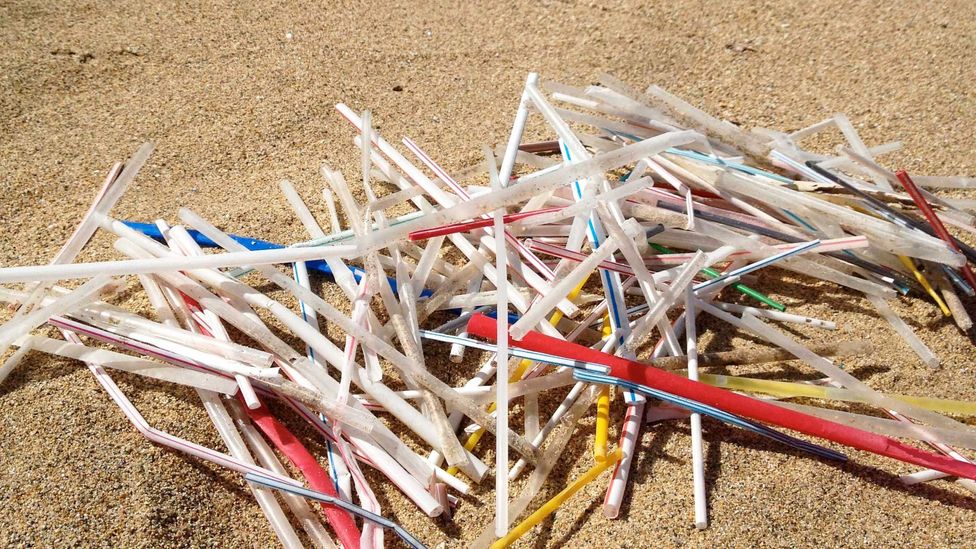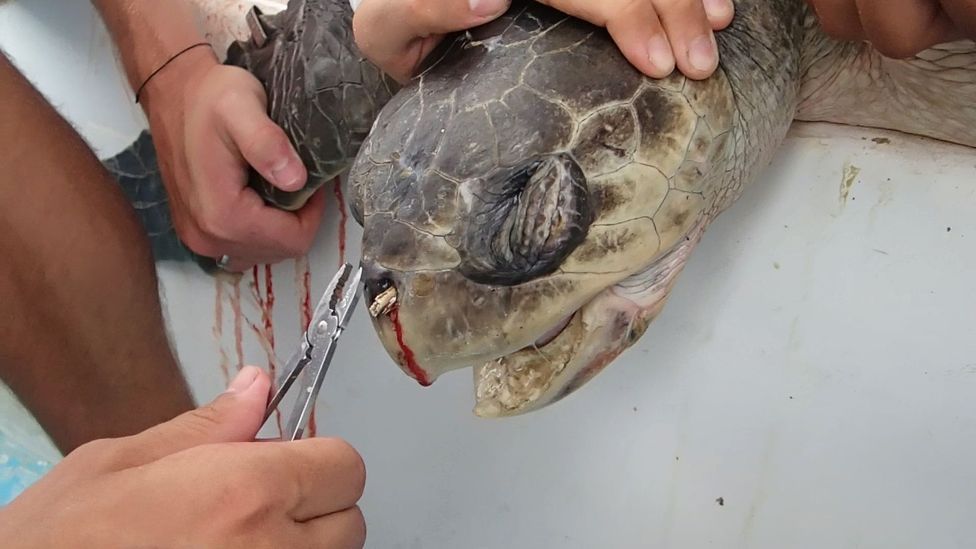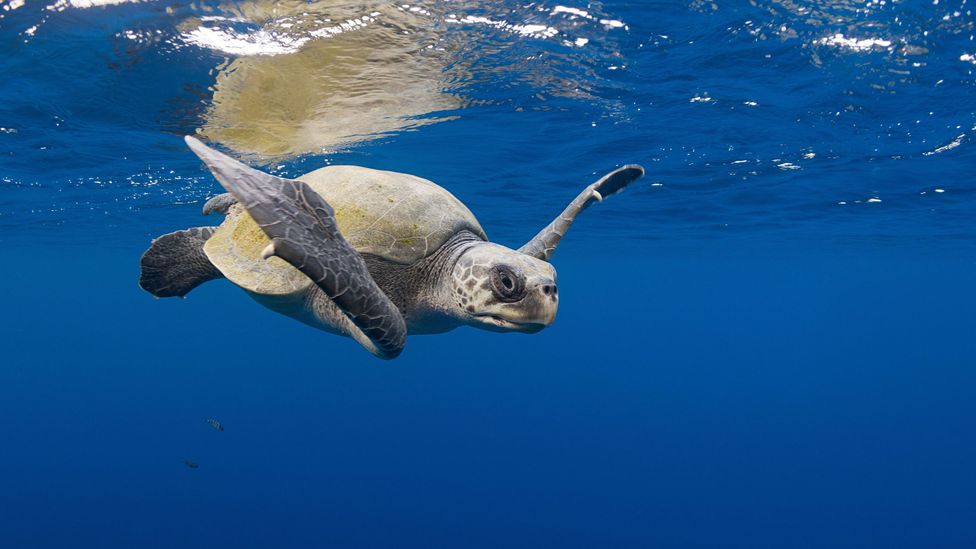In 2015, PhD student Christine Figgener was on a small fishing boat off Costa Rica's Pacific Coast examining an olive ridley turtle – when she noticed something strange coming out of its nostril. Curious, she started filming as one of her research colleagues began to investigate the object. At just over eight minutes long, the video documents the uncomfortable process during which they extract a plastic straw, while blood drips from the turtle's nose.
As a marine biologist, Figgener's focus was turtles, not plastics. However, plastic had always been an issue she encountered on the field, having witnessed turtles and other animals stuck in car tires, fishing nets or plastic bags.
"I wasn't an activist, but we scientists can't stay in our ivory tower. We see and document things that need to be communicated more broadly. It's not just about understanding, it's about getting people to care, and explaining what we can actually do," says Figgener. "Just looking at tonnes of plastic floating in the ocean can be a bit abstract, it's not the same as feeling the pain of another creature. It carried the message to non-scientists, showing what the statistics about plastic actually mean."
The anti-plastic-straw movement caught the world's attention after Figgener's video went viral. So, just how bad are single-use straws for the environment? Watch the video below to find out.
Years before the video surfaced, Jackie Nuñez had been picking up plastic straws just like the one extracted from the turtle. She regularly volunteered in beach cleanups in Santa Cruz, along California's coast and it opened her eyes to the scale of plastic pollution in the ocean. Not too far away, the Monterey Bay National Marine Sanctuary, a federally protected area, has a series of regulations to protect its diverse environment and rich biodiversity. One of the activities prohibited within the area is "injuring or disturbing marine mammals, seabirds and sea turtles". Although this is explicitly stated, the sanctuary can't control the fact that plastic waste does end up in the ocean, posing a severe threat to our ecosystems.
The turtle had become the symbol of the plastics crisis, giving the movement a memorable, suffering face
Plastics are known to hurt wildlife in different ways, including entanglement or ingestion, as several species confuse them for food. A new study found hundreds of plastic items in the guts of dead sea turtles in the Mediterranean, where more than 40% of turtles studied contained macroplastics – pieces larger than 5mm – including bottle tops and toys. According to the World Wildlife Fund, one in two marine turtles have eaten plastic – and many starve as their stomachs fill with plastic. The United Nations Environment Programme states that more than 8bn kg (7,874 tonnes) of plastic enter the oceans every year.

Caption: In 2011, Jackie Nuñez set up The Last Plastic Straw campaign in a bid to end single use plastics (Credit: The Last Plastic Straw)
"It got to a point where I was overwhelmed by the problem," says Nuñez. Among the most frequent items the volunteers picked up during the beach cleanups were plastic straws, which are particularly problematic single-use plastic items as they cannot easily be recycled due to their size, shape and material. She realised that a powerful way to help was to reduce the volume of plastic consumers use. She set up a website, worked with schools to raise awareness, and asked local restaurants to stop offering plastic straws by default, and instead only offer them to customers if needed.
Then, in 2011, she started a global campaign, The Last Plastic Straw. "We were making slow progress," she says. "There weren't many people talking about plastic straws at the time."
Suddenly, in August 2015 her inbox blew up with Figgener's video about the distressed turtle. It was also being widely shared on social media. Nuñez immediately reached out to ask for permission to use it in her campaign.
Once you see this, you can't un-see it – Jackie Nuñez
Figgener's video was going viral. The original now has more than 110 million views on YouTube, while a shorter version has over 15 million views. Figgener has since been interviewed by news outlets all over the world and, in 2018, she appeared in documentary film STRAWS. The film featured Figgener and her video, and was screened in the US, Malaysia, Greece, France, Italy, Hong Kong, Israel and several countries in the Caribbean, among others. The documentary was also included as in-flight entertainment on multiple airlines. After a 2018 campus screening, the Appalachian State University stopped using plastic straws, saving at least 444,000 plastic straws from landfill in one academic year, the university estimated.
The turtle had become the symbol of the plastics crisis, giving the movement a memorable, suffering face. Nuñez, now a programme manager at the Plastic Pollution Coalition, credits the video for jump-starting the global movement and raising awareness about the impact just one plastic straw can have. "Once you see this, you can't un-see it. It is very powerful," she says.

Straws have consistently topped the list of items collected during beach cleans – until now (Credit: Jackie Nuñez)
While you can't reduce the shift away from single-use plastics down to a single video, Nuñez believes Figgener's video did contribute to a massive shift in behaviour change, including towards implementing policies to eliminate single-use plastic globally. Over 30 countries have enacted nationwide bans on single-use plastic items, many of them after 2015.
A 2023 report by nonprofit Ocean Conservancy states that in previous years plastic straws consistently topped the list of items collected during their annual International Coastal Cleanups. But, more recently, their data shows plastic straws are being found at beach cleanups less frequently. In 2019, they were the third most common item collected, and by 2023 this had dropped to the 10th spot in the ranking. The report acknowledges that straws have become a "hot-button environmental villain" ever since this turtle video went viral.
"It started with straws, but it was only the start. People started questioning what else they could do, and the turtle video catapulted the whole conversation. It was the key that opened the door," Nuñez adds. Suddenly, she says, there were hundreds of campaigns.
In 2018, Stephanie Muttillo was working at Starbucks. After watching the video, she started an online petition with the image of the turtle, asking the company to eliminate plastic straws. Muttillo collected more than 147,000 signatures in just a few months. "The video heavily influenced me when I started the petition. I knew I needed to speak out about it," she says.
Shortly after, Starbucks backed her up. "It felt really good to get support, and that it wasn't falling on deaf ears," Muttillo adds. By July 2018, Starbucks published a press release committing to eliminate single-use plastic straws, promising to replace them with new "recyclable strawless lid and alternative-material straw options around the world". That same year, others followed – Alaska Airlines, Disney, McDonalds, Ikea and more – all announcing plans to phase out plastic straws.

When researchers removed a plastic straw from an olive ridley turtle's nose, the video went viral (Credit: Christine Figgener)
However, straws are just one example of many single-use plastic items, and evidence shows the global plastic pollution crisis is getting worse. Plastic consumption has quadrupled over the past 30 years. Not only is there more plastic than before, most isn't being recycled. The OECD found that in 2019, only 9% of plastic waste was recycled globally – with an even lower rate of 4% in the US.
Carbon count
The emissions from travel it took to report this story were 0kg CO2. The digital emissions from this story are an estimated 1.2g to 3.6g CO2 per page view. Find out more about how we calculated this figure here.
Figgener recognises there is still a long road ahead. "We need to go for real action, not get side-tracked by greenwashing or fast solutions that are not working. I think legislation, UN treaties and policy will lead to real change," she says.
And there is some traction in that direction. In 2022, UN Member States endorsed a historic resolution at the UN Environment Assembly (UNEA-5) to End Plastic Pollution, with the ambition of completing a draft legally binding agreement by the end of 2024.
"We are not going to fix the world by phasing out plastic straws," says Figgener. "That was never our intention, we never aimed so small. It was like a stone that fell into the water, and created little ripples that became waves… This really horrible thing inspired many people, and sparked something good."
--
If you liked this story, sign up for The Essential List newsletter – a handpicked selection of features, videos and can't-miss news delivered to your inbox every Friday.
